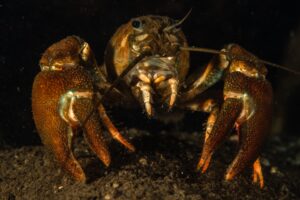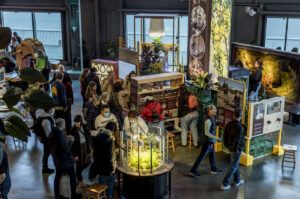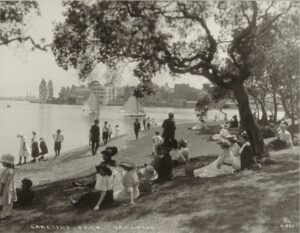The lights around Lake Merritt flicker off. Dawn has opened a shimmering, pink-feathered window in the pearl-gray sky through which daylight begins to pour over the water, dazzling, like liquid mercury. Buses rumble by. The workaday city shakes itself awake. It seems mere moments ago that I shared the dusky waterway with only the trees—humming and shushing in the breeze-laden night—and the lake’s winged denizens: snowy egrets stitching the water’s surface with needle-like beaks; black-crowned night herons, wary and aloof; a flotilla of coots, suspicious and red-eyed, patrolling the shadowy shallows. Quickly, it seems the pulse and population around Lake Merritt change. Traffic floods the boulevards that surround it. Footpaths fill with folks. Rowers pull their way across the waters. In the space of a few moments the lake is transformed from a wildly silent realm into a populous and shared kingdom, a place where people come to socialize, recharge, and regroup—145 acres of a hard-working natural space fulfilling the needs of a community.
- The Rotary Nature Center is open, to, well, everyone. Photo by Stephanie Benavidez.
It hasn’t been this way for long. Less than 200 years ago what is today Lake Merritt was a slough, the swampy north-pointing appendage (sometimes a finger, sometimes a hand) of San Antonio Creek, part of the tidal channel that would later become the Oakland Inner Harbor, and an integral piece of a 3960-acre watershed situated on a wide alluvial plain. Framed by thousands of acres of surrounding tidal marsh, the slough occupied 500 watery acres at high tide and 375 acres of mudflats when the tide was low. Alder, sycamore, live oaks, and California bays lined the banks of the streams that emptied into it. Herds of deer, elk, and pronghorn antelopes grazed the grasslands around it. Foxes, bobcats, coyotes, and mountain lions prowled the hills above it; countless numbers of ducks and geese touched down upon its inlets and channels—the skies were dark with them.
Few humans foraged the slough back then, although in the richly forested Oakland hills, Chochenyo-speaking Ohlone Indians seemed to have settled in a village along the banks of Indian Gulch Creek in an area that became known as Trestle Glenn. The Chochenyo fished the estuary, thanking Duck Hawk, the hero and benefactor who had made the earth a safe place for humans to live, for the food they took from it. By 1810, the Native Americans were gone, relocated to Mission San José by the Spaniards who had arrived with foreign presumptions: domination, possession, control. Title to the land passed, for the first time, into human hands.
Human history, unlike its natural counterpart, is written in a fast and spiky shorthand. By 1820 the slough “belonged” to Sergeant Luis María Peralta of Mission San José, part of a 44,800-acre land grant given in return for his years of service to the Spanish Crown. Title stayed with the Peralta family through Mexican independence in 1821 and cession to the United States. By 1848 the Mexican period had ended. Gold seekers swarmed the countryside, set up camp, and settled. It took less than four years for a couple of squatters—led by a sharpster lawyer, Horace Carpentier— to wrest ownership of the property adjacent to the slough from the Peraltas. They laid out a town, sold lots they didn’t own. Peralta won the legal battle that ensued, but the damage was done; there would be no turning back. Oakland was incorporated in 1852, Carpentier became its first mayor, and San Antonio Slough became a sewer.
By 1860 the condition of the waterway had become deplorable. From the town’s inception, clever Oaklanders directed raw sewage into the slough, which—due to the natural flushing action of the tides—they deemed exceedingly utilitarian. In time, they devised a system, involving 60 miles of brick and wooden drainage pipes, whereby all of the city’s waste could be channeled into the inlet. The Oakland Tribune called it, “without exception, the most perfect sewerage main in the world, no other city having such natural facilities.” The euphoria was sporadic and short-lived. It generally lasted until low tide, when the slough became a pestilent cesspool of stench.
In spite of its less than fragrant aroma, communities flourished on the marshy lands around the channel—the villages of Clinton and San Antonio on its eastern shore, and the town of Oakland on the west. The only east-west access was across the slough, so in 1853 Carpentier built a bridge at Twelfth Street, across the outlet to the estuary, charging (and pocketing) a toll.
But it was 1868 that ushered in the first human-induced change to the waterway’s hydrology, when Samuel Merritt, Oakland mayor and slough-side property owner, quite literally turned the tide on the slough’s declining appeal, and changing its character forever. Merritt proposed, spearheaded, and—when he found support lacking—personally funded construction of a dam at the Twelfth Street bridge that would control the tidal rise and fall through the inlet. This, he reasoned, would transform the slough from mud flat to lake, from a sewer to a source of civic pride. It didn’t take long for Merritt’s vision to become reality. San Antonio Slough became Lake Merritt, the nation’s largest body of salt water within a city limit.
At that time Lake Merritt still retained its fringing wetlands. Its thickly matted margins teemed with migratory wildfowl and a corresponding bird-hunting contingent who, in the newly possessive light in which the townsfolk now viewed the lake, began to seem more like poachers. Town leaders supported Merritt in his proposal for a wildlife refuge to cut the gunplay and protect the large flocks of migrating waterfowl for which the area was vital winter habitat. There’s little doubt that Merritt’s motives were self-serving, but the outcome was both beneficent and precedent-setting. Things happened swiftly. Merritt used his influence, and in 1870 the state legislature voted the Lake Merritt Wildlife Refuge into being, creating what would be the very first, legally-established public wildlife sanctuary in North America. The change in status made it unlawful to take or kill fish—except by hook-and-line—and prohibited taking birds for game.
There was, however, no provision made to protect the lake’s surrounding marshes, and these began to shrink under the pressure of development. The property around the lake qualified, by this time, as prime real estate. Residences soon dotted its muddy shores, and in spite of the inlet’s newfound popularity, the water quality continued to deteriorate. Two sewer systems were undertaken in 1868, the year Merritt had proposed the dam, but these weren’t finished until 1875. The battle with contamination continued for decades. Then, too, there was a certain natural reality. A mud flat is a mud flat. The “lake” kept silting up.
To city officials, dredging seemed to be the answer, and in 1891 the first dredging began. The dredged material was used to further alter the slough’s topography. It was deposited on the marshes to provide a foundation for a boulevard hugging the eastern shoreline. A stone bulwark was created there. The building of the roads commenced.
Change to the waterway happened quickly over the next few decades. Swept up in a national movement dubbed “City Beautiful,” inspired by the 1893-1894 Chicago World’s Fair, Lake Merritt was dredged, diked, and directed into its new role as a showplace of a recreational park. By 1915 its transformation was, if not complete, then irreversible. Adams Point, where lakeside development had begun less than a century before, had become Lakeside Park, sporting imported trees and shrubs as well as lawn bowling greens and tennis courts. The lake’s Trestle Glenn arm had become Eastshore Park, which included an ornamental boat landing at East Eighteenth Street and an elaborate Pergola at Castro’s Landing where the old wharf, or embarcadero, had once existed. At the south end of the lake, the Oakland Civic Auditorium was created. The roadways brought in heavy traffic, and in 1925—in celebration of the encircling boulevard—Lake Merritt was gifted with its “Necklace of Lights.” One hundred and twenty-six Florentine light standards and 3,400 pearly bulbs would shine from 1925 until 1941, when World War II blackout conditions forced them off. Ringed in concrete, circled in lights, the wild slough had been tamed, tarted up, and made suitable for community entertainment.
Today the lake is working hard. No longer a sewer, it now does duty as a wildlife refuge, recreational center, and a key component in Oakland flood control. More important, it’s still at work for nature as a hydrologic mixing zone where freshwater run-off from the Oakland hills (now channeled through pipes, culverts, and storm drains) mingles, via the outlet beneath Twelfth Street, with the salt water of the Bay. These days, the inlet’s water levels are highly manipulated. To assist in the process and to prevent the kind of flooding that would generally occur in periods of heavy rain, a pumping station was added in the 1970s. In winter, when rainfall and runoff from the surrounding hills is high, the water level is deliberately lowered. Salt water is flushed out; salinity decreases. In summer, when flooding is unlikely, the tidal inflow is encouraged; salinity jumps accordingly.
But shifts in salinity are only part of what is going on beneath this tidal inlet’s ever-changing surface. Lake Merritt is a virtual bouillabaisse. Ropes of microscopic algae float in and out with the tide. Tiny mussels, crabs, shrimp, and barnacle larvae—and other drifters like bryozoans and jellyfish—graze on the algae. Hordes of silvery anchovies gorge on both kinds of plankton, as do the smelt, those smaller relatives of salmon, that spawn in the lake in spring. And there are tubeworms; sluglike, fuzzy-antennaed mollusks called sea hares; fat rosettes of mature mussel and barnacle colonies; mud burrowing gobies and spiney stickleback—all part of the subaqueous host of squatters competing for the lake’s underwater real estate.
Situated on the Pacific Flyway—the western coastal highway for all migratory fowl—Lake Merritt is still a very popular stop. Its soupy brew draws pelicans and cormorants and terns and gulls and ducks and geese and herons, many of which nest and raise young on five man-made islands just off Adams Point. To really savor the flavor of this tidal bonanza, the fall and winter months—from September to February—are best. Then, the general wildfowl population swells with seasonal visitors. Rafts of feisty American coots scud back and forth over the lake. Fat-cheeked ruddy ducks dabble and dip far from shore. Emerald-headed mallard drakes and their plain brown mates socialize in the shallows close to the banks. Greater and lesser scaups, canvasbacks, pied-billed grebes, and the occasional goldeneye drift and dive in the deeper waters. Robins, starlings, house sparrows, scrub jays, and red-winged blackbirds hop about and hunt along the shoreline, and generations of Canada geese forage on the surrounding lawns. On rainy days the whole crowd’s at its best. Most sensible humans are hiding indoors, and Lake Merritt belongs once more, albeit briefly, to the birds.
Of course, for many Oakland residents the more cherished relationship is not the one with the birds, but the one between the lake and the city it serves. Seventy-five acres of park land provide a buffer between the lake and its inhabitants, and the urban community that surrounds it. A well-used walk around the three-mile shoreline winds past a variety of recreational facilities and civic structures. Ground zero is Lakeside Park on Adams Point where visitors find—tucked in between the 80 varieties of trees, shrubs, and plants—the Sailboat House, the old Lawn Bowling Greens, the James P. Edoff Memorial Bandstand, Children’s Fairyland, and the Rotary Nature Center.
It’s at the Rotary Nature Center where visitors can discover that, in spite of all the changes, Lake Merritt continues to be a functioning estuarine habitat, a small but significant piece of the largest estuarine system on the Pacific Coast. Supervising refuge naturalist Stephanie Benevidez, most recent in a long line that began with Paul Covel (one of the first full-time naturalists in the nation), will explain the natural interactions of a vital ecosystem that has had to change to accommodate man. She emphasizes an approach to nature that is functional rather than academic, honed by years of sharing her knowledge of the lake with several generations of future nature-lovers, easily telling tales of the mishaps and fiascos that have plagued the lake since people first laid hands on it. It’s not a pristine system, nor can it be, given the world that has grown up around it.
Stephanie likes to see humans and nature connecting. “It’s about the cycle of life,” she says. “People raise their young around the lake. The children come back and work at the nature center. I’d like to see a billboard featuring our geese and goslings. It would say, ‘Oakland is a great place to raise a family.’”
Development has not been without its casualties. The changes in hydrology—some from continuing urbanization, industrialization, and utilization of the lake and its watershed, and some reflecting changes in the Bay as a whole—have precipitated corresponding changes in the populations of birds, invertebrates, and fish that make the lake their home. Rechanneling the creeks has cost the lake its population of freshwater fish and made room for other species. Portuguese barnacles, widgeon grass, green mussels, and Pismo clams have all been vigorous intruders, muscling out natives. Mitten crabs and Chinese long neck clams wait ominously in the wings. Indigenous or imported, it’s the more resilient species that persist; and since the most resilient species seems to be Homo sapiens, success or failure of the other lake inhabitants depends on an ability to adapt to human presence. That presence can be destructive. Clearing away the underbrush for footpaths has driven off creatures like quail and reptiles that relied on it for cover. Oil slicks periodically foul the lake. Some city residents still pour contaminants into storm drains.
There are also grave misunderstandings: citizens releasing fresh water turtles in what is essentially a salt water system; the importation of a colony of gregarious, but not altogether friendly, monkeys; the introduction of red squirrels, with disastrous results for the ground squirrel population. Then there’s the tendency to interpret the success of any other species as a threat, as seen in the public frustration with the growing numbers of Canada geese and their waste byproducts. I like to think about the days when flocks of migrating birds darkened the skies, when humans were in the minority, when aggressive geese, their numbers, and their droppings didn’t cause a stir.
Mostly, I’m amazed at how we can’t leave the natural world alone. How we have to domesticate it, shape and control it, maybe dress it up to somehow make it better. Take the Necklace of Lights, for example. It’s back—a sentimental contribution from the citizenry to decorate the lake that they adore.
My friend Susan expresses her ambivalence. “At first,” she says, “I didn’t like the lights. I think I like them now.”
I tell her how the necklace reflects the esteem in which the city holds the lake, how it’s a token of that esteem, a symbol of appreciation; but all along, I’m thinking about the cost of that appreciation. There’s something essentially destructive in our personification of the natural world, but I must admit it’s difficult to resist.
It’s nighttime on the lake again. Sunlight snakes crazily across the water, shadows slither from the banks, and gold begins to explode over the surface, chased by oily darkness. The necklace of lights twinkles on. There’s no denying it, the lake’s a working girl. Still beautiful, but with a job to do. Perhaps that’s why I love her.

.jpg)




